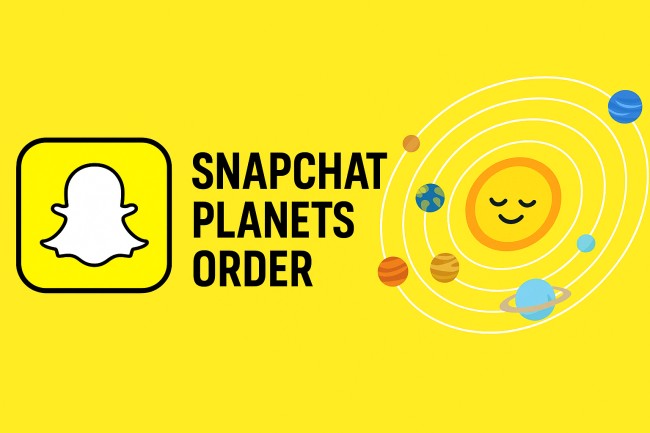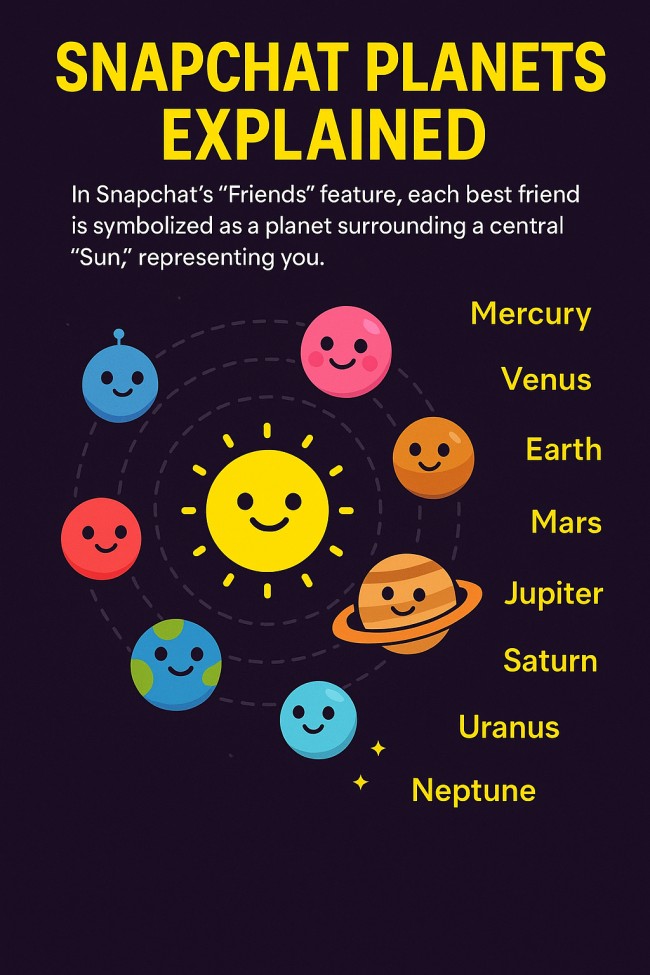
Snapchat uses more than messages and streaks to track social engagement. Its Friend Solar System ranks close connections with a visual twist. Users with Snapchat Plus see friends represented as planets in a solar system around a Bitmoji sun. Each planet represents a level in the friend ranking system.
The feature looks playful but relies on behavioral signals. It helps users gauge how strong their digital ties are – based on conversations, Snaps, stories, and mutual interactions. Understanding the Snapchat Planets Order can reveal how the app assigns value to relationships without revealing exact metrics.
What Is Snapchat Planets Order?
Snapchat Planets is part of the Snapchat Plus subscription. It introduces a solar system metaphor where each “planet” stands for a different best friend rank. A user appears at the center as the sun. Around the sun, up to eight friends are displayed, each linked to a planet.
Each planet doesn’t just represent a spot. It mirrors the real planetary order of the solar system – Mercury through Neptune – ranked by proximity to the sun. The closer the planet, the stronger the relationship on Snapchat.
Here’s what each planet stands for in the Snapchat Planets Order:
- Mercury – Best Friend #1
- Venus – Best Friend #2
- Earth – Best Friend #3
- Mars – Best Friend #4
- Jupiter – Best Friend #5
- Saturn – Best Friend #6
- Uranus – Best Friend #7
- Neptune – Best Friend #8
The order does not reflect public rankings. Only the Snapchat Plus user can view it, and only for mutual best friends.
How Snapchat Determines Best Friends
Snapchat tracks user interaction data in the background. It observes:
- How often Snaps are exchanged
- The number of chats
- Story engagement
- Reactions and Bitmoji usage
- Consistency over time
Each behavior adds to a score. That score feeds into a ranking algorithm. The higher the score with a specific contact, the closer they are in the planet system.
The planets don’t replace the original Best Friends list. Instead, they add a layer of personalization for Snapchat Plus users. Only users with mutual Best Friend status can see each other’s placement in the Planets view.
Snapchat Planets Explained
1. Mercury – Closest Bond
Mercury sits nearest to the sun. The person assigned to Mercury shares the strongest connection. Daily chats, frequent Snap sharing, and mutual reactions push someone into this position.
2. Venus – Second Place
Venus marks a strong bond, just a step below Mercury. Snaps are frequent, but not as consistent. Engagement might be steady over months but with less daily frequency.
3. Earth – Third Rank
Earth signals a meaningful connection, though interaction might drop during certain periods. This friend likely sees occasional Snaps, longer gaps in conversations, or one-sided communication at times.
4. Mars – Fourth Position
Mars indicates sporadic interaction. There’s a history of Snapping, but daily communication may not be present. A few streaks might’ve broken. Fewer replies over time can also lead to this rank.
5. Jupiter – Fifth Friend
Jupiter begins the outer ring of friendships. These contacts receive some attention but rarely appear in recent chat lists. Snaps may be one-off or irregular. Group chats could influence this position.
6. Saturn – Sixth Tier
Saturn shows weak engagement. There might have been a past streak or a few shared stories. Current communication is likely one-sided or passive.
7. Uranus – Seventh Friend
Uranus points to minimal interaction. There may be occasional views of stories or emoji reactions but no consistent Snaps or messages.
8. Neptune – Eighth Friend
Neptune is the farthest and often represents an inactive friend. There’s little interaction now, though there may have been past contact. Story views or Bitmoji taps might be the only remaining signals.

Visual Differences Between Snapchat Planets
Snapchat assigns unique visuals to each planet. These include colors, rings, and moons – mirroring real planetary features:
- Mercury: Small gray planet, no rings.
- Venus: Yellow with no moons.
- Earth: Blue with a moon, some green highlights.
- Mars: Red surface with small moons.
- Jupiter: Brown-orange stripes, several moons.
- Saturn: Iconic rings, light beige body.
- Uranus: Pale blue with faint rings.
- Neptune: Deep blue with a textured surface.
These visuals help identify the friend’s rank at a glance. The differences are designed to be fun but still match Snapchat’s minimalist design.
Snapchat Plus and the Planets Feature
The Snapchat Planets Order is part of Snapchat Plus, the platform’s premium tier. It offers additional tools beyond Planets, such as:
- Story rewatch counters
- Custom app icons
- Priority replies to Snap Stars
- Ghost Trails
- Best Friend Solar System
Only Snapchat Plus users can see the solar system view. Regular users receive traditional Best Friend emoji indicators but don’t see planets or positions.
The Planets system is opt-in and designed for curiosity, not public ranking. Friends do not receive a notification when they become Mercury or Neptune. The data stays private.
The Purpose Behind Snapchat Planets
Snapchat built this feature to gamify digital relationships. It adds visual storytelling to data already collected. Instead of listing names or scores, the solar system shows proximity in a metaphorical way.
This rewards active communication. It also keeps users guessing – why someone moved from Mars to Earth or dropped from Venus to Neptune. In doing so, Snapchat creates emotional hooks. It draws users back in without needing leaderboards or public stats.
Snapchat Planets also encourage reflection. Users might notice how relationships change based on conversation frequency or engagement style.
Privacy and Snapchat Planets
The Planets feature does not share rankings with other users. Friends only appear if both users have each other as Best Friends. Even then, only the person with Snapchat Plus can see the planet rank.
Snapchat’s privacy policy covers interaction metrics. While the platform uses data for rankings, it doesn’t publish exact algorithms. Rankings are dynamic and can shift weekly based on interaction trends.
There are no manual controls. Users cannot assign or pin someone to a specific planet. The entire process runs in the background.
What Affects Friend Planet Position?
Several factors influence a friend’s placement in the Snapchat Planets Order:
- Snap Frequency: More Snaps exchanged = Higher placement.
- Chat Consistency: Long, consistent chats push someone up the ranking.
- Story Engagement: Frequent story views, replies, and emoji reactions signal interest.
- Reciprocity: Mutual Snaps and reactions count more than one-sided messages.
- Timeframe: Recent activity weighs more than past behavior. Old streaks have less effect.
- Exclusivity: If many people are contacted equally, no single person will reach Mercury.
Friendships aren’t fixed. Someone can drop several places in a week if interaction dips or a new friend enters the picture with more activity.
Misconceptions Around Snapchat Planets
Some users believe the planets show who ranks them highest. This is incorrect. The solar system reflects how others rank in one user’s interaction data – not the other way around.
The Planets also do not show all friends. Only eight mutual Best Friends are included. Others remain outside the system.
The feature doesn’t include Snapscore or profile views. It’s not a measure of popularity, only private interaction depth.
Are Snapchat Planets Accurate?
The accuracy depends on recent activity. If usage patterns shift – say, daily messages with someone new – planet ranks adjust quickly. A friend can go from Neptune to Mercury in under a week with sustained interaction.
However, the system isn’t perfect. It doesn’t weigh emotion or conversation quality. Passive interactions like emoji reactions still count. This can skew placements if engagement is shallow but frequent.
How Snapchat Planets Compare to Other Social Metrics
Unlike Instagram’s Close Friends or Facebook’s Top Friends lists, Snapchat’s Planets don’t require manual setup. They change automatically based on behavior. That makes them reactive rather than curated.
The closest parallel is Spotify Wrapped – data turned into a visual story. Snapchat Planets use metaphor and motion, not numbers or charts. That subtle difference keeps Snapchat focused on experience rather than competition.
Can Snapchat Planets Be Turned Off?
Snapchat Planets cannot be disabled entirely without ending the Snapchat Plus subscription. However, no notifications are sent when planets shift or reset. Users can ignore the feature if they prefer a simpler experience.
There’s no public-facing display of ranks, and Bitmojis do not show planets to others. Only the subscriber sees the solar system view.
FAQs on Snapchat Planets Order
1. What is the Snapchat Planets Order?
Snapchat Planets Order is a visual feature in Snapchat Plus that ranks a user’s top eight mutual best friends using planets in a solar system, based on interaction frequency.
2. How does Snapchat decide which planet a friend gets?
Snapchat uses data such as Snap frequency, chats, story engagement, and mutual activity to rank friends. The most interactive friend appears as Mercury, the closest planet to the Bitmoji sun.
3. What does Mercury mean on Snapchat Planets?
Mercury indicates the top-ranked best friend—the person with whom the most frequent and consistent interaction happens on Snapchat.
4. Can Snapchat Planets be seen by other users?
No, only Snapchat Plus users can view their own friend’s planet placements. Other users cannot see which planet they appear on in someone else’s system.
5. Why do planet positions change in Snapchat?
Positions change as user interactions shift. If someone interacts more often with a different friend, the planet ranking adjusts to reflect that change.
6. Do Snapchat Planets affect streaks or Snapscore?
No. Planets are separate from Snapscore and streaks. They only reflect best friend status based on recent behavior and engagement patterns.
7. Can a user change someone’s planet manually?
No. Snapchat Planets are determined automatically. There’s no option to pin or reorder planets manually.
8. Do Planets include one-sided friendships?
No. A user must have mutual best friend status with someone for them to appear in the planet system.
9. How often does Snapchat update the Planets Order?
Snapchat updates the Planets Order dynamically. Changes can occur within a few days based on recent interactions and engagement levels.
10. Can two friends appear on the same planet?
No. Each of the eight planets corresponds to one individual friend. No two friends share the same planet in the ranking.
Conclusion:
The Snapchat Planets Order offers a new layer of engagement for Snapchat Plus users. It reimagines friend rankings as a visual orbit system. With Mercury as the top rank and Neptune as the lowest, the feature brings playful symbolism to digital behavior.
Behind the design lies a data-driven system. It observes patterns, reacts to changes, and reorders friends without needing user input. While the planets don’t tell the whole story, they offer a fresh way to reflect on Snapchat relationships.
Also Read:

